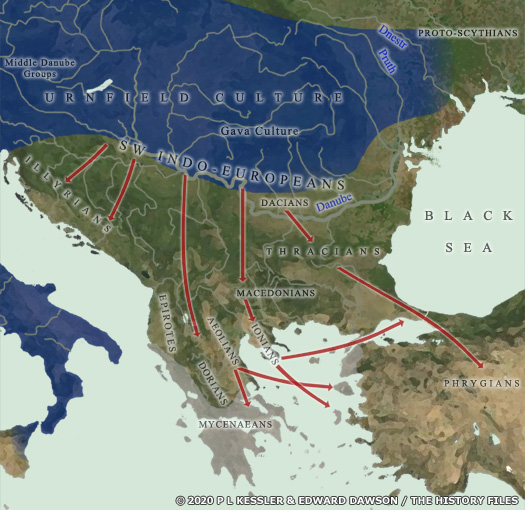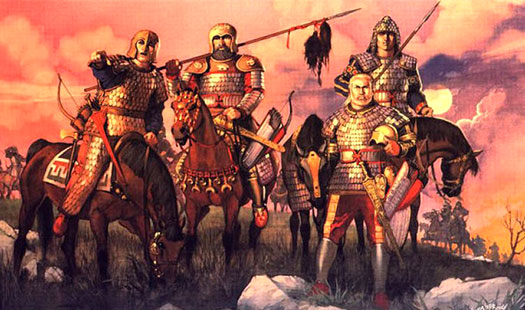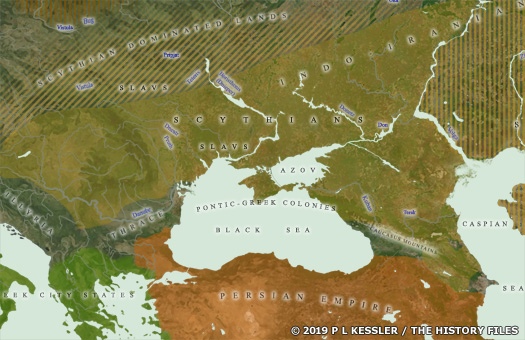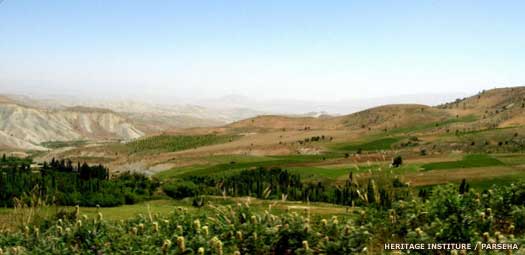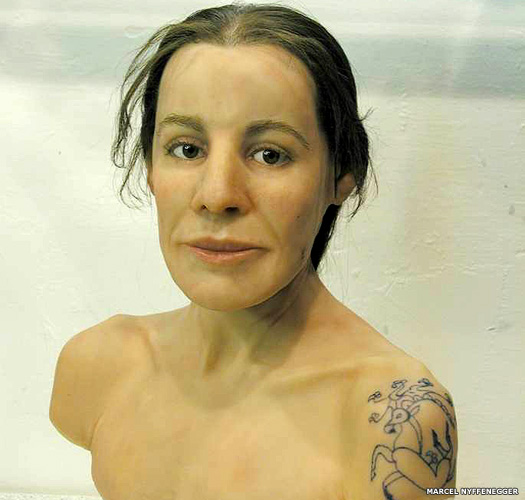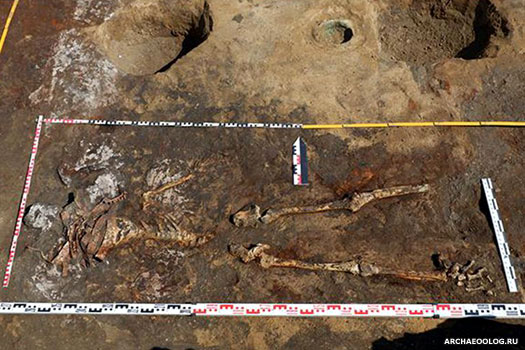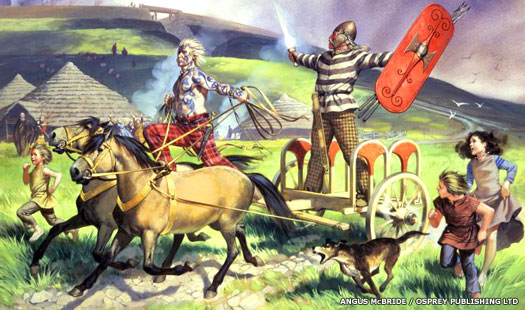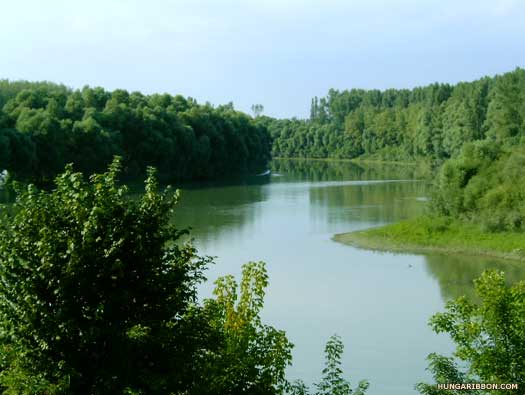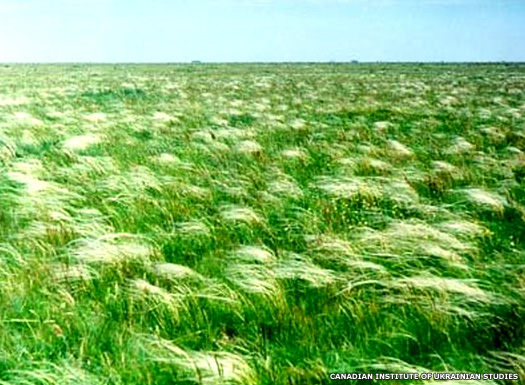
| SCYTHIANS Incorporating the Aspasioi, Aspisi, & Gerrians :
As the successors of the southern Russian Srubna/Timber-Grave culture, the Scythians were semi-nomadic pastoralists who occupied much of the northern shores of the Black Sea. They herded their precious cattle from pasture to pasture throughout the year while travelling in wheeled carts or mounted on horses that had been bred on the Pontic-Caspian steppe for as much as three thousand years before the Scythians themselves were first recorded in history. In this they were no different to their ancestors, the Indo-Europeans whose massive outward migrations formed the Yamnaya Horizon between about 3500-2500 BC.
While the western branch of the Indo-European-speaking groups - the centum-speakers - largely headed towards Central Europe and Scandinavia, the eastern branches were much less adventurous at first, generally filling the void on the steppe. These groups, classed as Indo-Iranians, would eventually supply migratory peoples such as the Persians and Medians, and the Indo-Aryans of northern India. They also supplied the Sakas who dominated Central Asia by the middle of the first millennium BC. The Scythians themselves were essentially the same people as these Sakas - simply their westernmost groups spread across what is generally now southern Russia and Ukraine. They were more often recorded by Greeks rather than Persians (although certainly not exclusively), but in essence both names almost certainly come from the same original word, whether 'Saka' or 'Scythian' (which may mean 'knife' or 'sword'). Their land became known to the Greeks as Scythia, and that name easily outlasted the political and cultural unity (if such a thing existed) of the Scythians themselves. It was still being used in the fifth century AD to illustrate the advance of hybrid Indo-Iranian/Turkic tribes into the Pontic-Caspian steppe.
The Scythians would also seem to have dominated the early Slavs, prior to their outwards expansion following the collapse of the Hunnic empire. Slav origins have generally been pinned to the area between the Middle Dnieper and the Bug, both well within Scythia. By the fifth century BC when that domination is heavily suggested by Herodotus, the Scythian and Slavic languages may still have been mutually almost-intelligible, rather like Italian and Spanish today. Conversations may have been heavily sprinkled with 'huh?' and 'what?' of course, but the meaning would have been grasped. The Slavs were never turned into Scythians. Instead they were always subjugated peoples who were ruled by an Indo-Iranian elite in the form of the Scythians. They would seem to have been the farmers for whichever nomad group was in command of the region, right down to the Huns of the fourth century AD.
The Aspasioi and Aspisi are the same people, recorded by separate Greek writers with variable spelling. Otherwise obscure they are recorded by Strabo as being the northern neighbours of the Massagetae. As the Massagetae are most likely to be Scythian rather than Saka (ancient writers distinguish between them), it is most likely that their northern neighbours are also Scythian. There was an Asioi tribe of the Greater Yuezhi - the name is very similar, possibly the same, but there is nothing to prove a connection. The '-oi' in Aspasioi is the Greek suffix, so it should be pronounced 'As-pas', with the ancient core name, 'As' also being linked to Germanic origins (see feature link, right).
The Gerrians are introduced into the historical record by Herodotus. He names them and then says that 'on the other side of the [River] Gerros we have those parts which are called the "Royal" lands and those Scythians who are the bravest and most numerous and who esteem the other Scythians their slaves'. From this it would seem that the Gerrians are themselves Scythians, but subject to the 'royal' Scythians. This is not certain however. The Slavs were also termed 'Scythian farmers' so the possibility exists that the Gerrians were another group of Slavs.
When it comes to influences and interaction, the name 'Gerros' which is used both for the river and the region is rather intriguing. Remove the Greek suffix and 'Ger' remains. It is understood that the Germanic groups (western Indo-Europeans but with a mysterious influence by eastern Indo-Europeans) are supposed to be named after their spears, but what if the spears are named after the men? This is not unlikely. The word 'man', for example, dropped out of usage in Latin, replaced by 'homo', a shortened form of 'humanus', meaning 'earth man'. The word 'man' had instead been transferred to refer to a man's hands, with 'man' literally referring to a hand. Such a shift is similar to English naval slang in the last half of the second millennium AD, with 'hands' being taken to refer to men, as in 'all hands on deck'. This supplies the possibility that the mysterious eastern Indo-European influence on the Germanics in Scandinavia was in fact Saka (Scythians) who originated from around Gerros.
(Information by Peter Kessler and Edward Dawson, with additional information from The Origin and Deeds of the Goths, Jordanes, from Comments on Indo-Iranians and Tokharians: a response to R Heine-Geldern, Marija Gimbutas (American Anthropologist, 1964.66:893-898), from The Histories, Herodotus (Penguin, 1996), from The Horse, the Wheel, and Language: How Bronze-Age Riders from the Eurasian Steppes Shaped the Modern World, David W Anthony, and from External Links: The Balts, Marija Gimbutas (1963, previously available online thanks to Gabriella at Vaidilute, but still available as a PDF - click or tap on link to download or access it), and Scientists may have unearthed 'permafrost tomb' of ancient Siberian prince (MNN), and Experts Unearth 2,400-Year-Old Solid Gold Bongs In Southern Russia (Tech Times), and Encyclopaedia of Ukrainian History (in Ukrainian), and Tomb Containing Three Generations of Warrior Women Unearthed in Russia (Smithsonian Magazine).)
c.1200s BC :
From an early date, quite probably before their existence is recorded (and the 1200s BC has been mentioned as a likely period), a large proportion of the early Slavs in the Middle Dnieper basin fall under the rule of the Scythians. The Finno-Ugric tribes and the eastern Balts living in the forested areas to the north remain outside the orbit of strong Scythian influence.
The appearance of ferocious mounted Scythian warriors in the lands to the south of the Balts must have instilled a sense of worry and fear in many groups, but the Balts always managed to remain independent of their control (although armour such as that pictured here certainly did not appear so early), while above is a map showing the early Scythian lands before they came to the notice of Classical authors 12th century BC :
Iron appears in Central Europe in this century, but not until the eighth century does it revolutionise lives and only then does it reach Northern Europe. Between the eighth and sixth centuries iron is still extremely rare in territory that is controlled by the Balts, and the general cultural level continues to have almost a pure Bronze Age character. The dividing line at about the end of the eighth century BC signifies a change in culture due not so much to technological innovation as to new historical events - the appearance of the Scythians (any precise dating for that appearance being, of course, debatable).
9th century BC :
In 2018 it is reported that a 'permafrost tomb' of an ancient Siberian prince has been unearthed. The previously undisturbed tomb is located in southern Siberia (in the Russian republic of Tuva), with its contents additionally being entombed in ice. It lies underneath a typical Indo-European kurgan burial mound. These circular structures, consisting of a stone packing with a circular arrangement of chambers, are royal tombs that belong in this period and region to the Scythians. The impressive find is declared the largest and oldest of its kind ever discovered in what is increasingly becoming known as the 'Siberian Valley of the Kings'.
c.800 - 600 BC : This is the period of Scythian expansion from the Black Sea area into Central Europe. These steppe horsemen who appear in Moravia (now eastern Czechia), and what is now Romania and Hungary (and who are almost certainly but not inarguably Scythians) are the successors of the southern Russian Srubna culture of the Bronze Age which itself had constantly been pushing towards the west. These Scythians introduce eastern types of horse gear, oriental animal art, timber graves, and inhumation rites (gaining the name of Timber-Grave culture from this). Before entering Central Europe, they conquer the Cimmerians on the northern shores of the Black Sea and in the northern Caucasus, driving them out and dominating the northern Black Sea region.
This map attempts to show the Scythian lands at their greatest extent, failing to extend northwards thanks to the Balts Now also dominating eastern Anatolia and the Zagros Mountains they acquire much of the Caucasian and Cimmerian cultural legacy and mix this with their own Pontic-Caspian steppe cultural elements. These oriental influences appreciably change the material culture of Central Europe. The Baltic and Germanic cultures in Northern Europe remain untouched by the Scythian incursions, but the new cultural elements reached them through continuous commercial relations with Central Europe.
fl c.700s? BC :
Koloksai : Legendary dynasty founder mentioned by Alcman of Sparta.
? - c.675 BC :
Ishpaka / Ishkapai / Ishpakai : Scythian king. Killed in battle.
c.675 BC :
The Median ruler, Xshatrita II, becomes an ally of Ishpaka's around 678 BC, but the Scythian king is killed in battle against Esarhaddon of Assyria around 675 BC. Apparently his followers are confined (by the terms of their surrender?) to the land to the south of Lake Van. Clearly this particular group of Scythians is operating and presumably living far south of Scythia itself.
c.675 - 645 BC :
Bartatua / Par-ta-tu-a : Scythian king around Lake Van.
c.674 BC :
With Media's alliance of Cimmerians, Mannaeans, and Scythians having crumbled, Bartatua seals an alliance with the Assyrians around this date, presumably by marrying a daughter of the Assyrian king. It is possible that these Scythians become dominated by the powerful Tugdamme of the Cimmerians. He begins to threaten the borders of the powerful Assyrian empire during the reign of Ashurbanipal and is recorded as being 'King of the Saka and Qutium' - Sakas and Scythians are one and the same people.
The Zagros Mountain range provided the Medes with their home, but it was also the Assyrian gateway into Iran, one that was used in later attacks on the Indo-European Persians and Medes 653 BC :
Xshatrita II of Media leads the league that endangers Assyrian control of the Zagros Mountains and is himself killed in battle against Assyria. He is succeeded by his young son, but the Medians are quickly subjugated by a Scythian invasion of the steppes. One of their number - Madys - rules the Medes and associated Iranian tribes, and it takes the Medians under Huwaxshatra almost thirty years to restore their independence.
c.645 - 625 BC :
Madys / Madius / Madyes / Madya : Son. Scythian king of the Medians (653-625 BC). Killed.
625 BC :
Herodotus says that Huwaxshatra of Media reigns for forty years including the time of the domination of the Scythians, but virtually all historians agree that what is meant is forty years excluding the time of the domination of the Scythians. At the beginning of his reign, Huwaxshatra is considered a vassal of the Scythians until he throws off their yoke in 625 BC and takes sovereign control of his country.
Madys and his fellow leaders are massacred by the Medians while his defeated people flee back into Scythia, abandoning their former territory to the south of the Caucuses Mountains. Once there they begin the reconquest and renewed domination of the 'lesser' Scythian tribes. Presumably included amongst this number are the Slavs.
c.600 - 500 BC :
The Lusatian culture still persists in the first centuries of the Early Iron Age. The amber trade is not cut off and the Lusatians continue to be mediators between the Baltic and Germanic amber gatherers and the Hallstatt culture in the eastern Alpine area and, beginning in the seventh century, the Etruscans in Italy. Under great pressure due to Scythian raids, the Lusatian eventually gives way to the Pomeranian Face-Urn culture.
The Scythians reach the southern borders of the western Baltic lands, seemingly due to their becoming involved in wars against the Persians who are invading Scythia from the south. Herodotus describes these wars in Book IV of his history, these being the earliest surviving written records concerning the history of Eastern Europe at the end of the sixth century BC. Apparently, though, the Scythians do not succeed in penetrating farther north. Only a few arrowheads of Scythian type have been found in East Prussia and southern Lithuania. A chain of western Baltic strongholds in northern Poland and in the southern part of East Prussia arise which very probably are built for resisting the southern invaders. The Scythian high tide lasts only until the end of the fifth century BC. After that they no longer appear in the north, and possibly it is Baltic resistance which helps to end the Scythian threat.
Allusions to some tribal names may be regarded as references to the Baltic and Finno-Ugric tribes. Herodotus describes an expedition undertaken by the Persian King Darius against the Scythians in 515 BC. He mentions and approximately locates the seats of the 'Neuri', 'Androphagi', 'Melanchlaeni', 'Budini', and other tribes living to the north of Scythia. Marija Gimbutas especially uses Herodotus to locate the Neuri by establishing the Pripet marshes to be the natural border between Scythia and the Neuri, while the 'Scythian farmers' of the lower and middle Dnieper basin are almost certainly subject Slavs.
6th century BC :
The Harii probably belong to the Hallstatt culture of Celts. They are to be found around the central Germanic lands, and in Bohemia, Moravia, Slovakia, and the edges of Poland and Ukraine. Around this time a large-scale expansion begins that sees many Hallstatt Celts migrate outwards, but generally towards the west without disturbing the Scythian lands.
c.500 BC :
Between about 500 to 400 BC large numbers of Iron Age La Tène Celtic peoples migrate to the east to locations in Poland, the modern Czech Republic, Slovakia, Hungary, the Balkans, and east to Ukraine. Also from this period comes the 'Siberian Ice Maiden' (alternatively referred to as the Princess of Ukok or the Altai Mummy), a tattooed Scytho-Siberian mummy discovered by archaeologists in 1993. She lives at this time on the Eurasian steppe as a member of the Pazyryk culture which is current at this time. Aged between twenty and thirty at the time of her death, her remains are entombed in a subterranean chamber beneath a kurgan mound.
Scientific research has shown that the 'Siberian Ice Maiden' died of breast cancer and that she also suffered from several other ailments, with the pain and discomfort possibly being helped by using cannabis which was kept in a small pouch that lay beside her body in the grave fl c.450s? BC :
Ariapeithes : Scythian king. m daughter of Teres I of the Odrysae.
mid-400s BC :
Ariapeithes' name is highly typical of Indo-Iranians. The first part, 'Aria', is a variation of 'Arya', usually shown as Aria (Latin), Areia (close to the Greek spelling), Haraiva (Persian), or Haraeuua (Avestan). The Areioi tribe of Indo-Iranians bear another variation of the same word. The name Arya appears to be the oldest one known for Indo-Europeans. Ariapeithes himself marries the unnamed daughter of Teres I of the Odrysae but is murdered by Spargapeithes of the Dacian Agathyrsi.
fl c.430s BC :
Scyles / Skyles / Scylas : Son. Promoted Greek culture. Executed by his brother.
c.430 - 425 BC :
The half Thracian Scyles is chased out of the Scythian kingdom by his own people due to his continuing promotion of Greek culture and traditions. He takes shelter with his relatives in the Odrysian kingdom but is followed by Octamasadas, his Scythian successor and full brother. After a certain amount of warfare between Odrysians and Scythians, Scyles is handed over as part of a prisoner exchange. He is subsequently executed.
fl c.420s BC :
Octamasadas : Brother.
fl c.420s BC :
Oricos : Brother.
c.400 BC :
The Celts of the La Tène culture arrive in Bohemia and southern Poland, the northern limit of Celtic expansion, although there remains the question of where the Belgae and Venedi are located. This La Tène expansion is led by the Boii tribe which makes Bohemia its home for the next three centuries, but the same expansion also stops the Pomeranian Face-Urn culture from expanding any further south. Western and southern Poland have also been disrupted by Scythian raids, but these suddenly drop off around 400 BC, leaving the Face-Urn culture free to expand instead across the entire Vistula basin and to reach the upper Dniester in Ukraine, thereby bypassing the La Tène Celts.
In 2019 findings were announced regarding four female Scythian burials at Devitsa in Russia (to the north-east of the border with Ukraine), all of which could be dated to the 300s BC and which contained weapons - the eldest of the four women was even buried 'in the position of a horseman', riding as one of Herodotus' warrior Amazons would have done In 2013 archaeologists discover opium and cannabis equipment and other gold items in a Scythian kurgan named Sengileevskoe-2. Located in southern Russia, the finds are dated to around 400 BC. It is generally understood that the Scythians smoke and brew a concoction that contains cannabis and opium, with warriors doing so to place them in a certain state of mind before they head into battle.
350s? - 339 BC :
Ateas / Atheas / Ateia / Ataias : 'Most powerful' Scythian king. Killed in battle.
339 BC :
Ateas is a Scythian ruler of the fortified settlement of Kamenka. He seems to be viewed as a usurper, someone who has defeated and subjugated the traditional ruling establishment and its three cooperating rulers to unify and command a greater number of Scythians than usual. He may not even be of the traditional ruling class. By the 340s BC he rules the territory between the River Danube and the Maeotian marshes (close to the Sea of Azov near the Crimea) - essentially much of Scythia.
Following increasing contact with the Macedonian kingdom to the south of Scythia, Ateas enlists Macedonian troops to help him in a battle against the city of Histria on the coastal shores of Thrace. Histria's king dies suddenly and the Macedonian troops are summarily dismissed upon their arrival. Further petty insults are traded between Ateas and Phillip II of Macedon until the two sides go to war in 339 BC. The battle takes place on the plains of what is now Dobruja, with Ateas being killed in action, his army routed, and his kingdom collapsing.
c.250 BC :
Germanic settlements have spread only a little farther south-westwards along the North Sea coastline, and eastwards into the heart of modern Poland and northern Germany. One exception to this is the tribe of the Bastarnae. They have already reached the Balkans by this time thanks to which they are often mistaken for being Scythians by Greek and then Roman writers.
The Bastarnae exhibit early Celtic influences, seemingly overlaid by Germanic cultural and language elements, but once they had relocated to the Balkans they were often mistaken by contemporary writers as Scythians fl c.130s? BC :
? : Unnamed father and Scythian king.
? - c.100 BC :
Scilurus / Skilurus / Skylurus : Son and Scythian king of the Tauri.
100s BC :
Scilurus is both the father of a Scythian king and the son of one, while himself also serving as king during part of his own lifetime. His capital is Scythian Neapolis (or 'new town'), founded in the third century BC and surviving until the third century AD when it is destroyed by Goths. It is located on the Tauric Chersonesus (the land of the Tauri, now the Crimea), although the surviving ruins are surrounded by the town of Simferopol.
His domains include Crimea itself over to the Dnieper which exits into the very northern tip of the Black Sea - clearly a much smaller territory than that controlled by Ateas two centuries before. However, like before there is strong competition in the region for domination. Although initially an ally of Mithradates VI 'the Great' of Pontus, this resourceful and powerful regional authority soon becomes an enemy who is responsible for the death of Scilurus around 100 BC.
c.100 BC :
Palacus / Palakus : Son and Scythian king - the last to be named in sources.
c.100 BC :
Palacus continues to fight Mithradates the Great of Pontus. An attempted siege of Chersonesos (Crimea) is defeated by Pontic troops, so Palacus enlists the Roxolani under Tasius and launches an invasion of Chersonesus. This too is defeated and the Scythians are forced to accept Mithradates as their overlord. The former capital of their kingdom now becomes the capital of the Cimmerian Bosporus kingdom.
1st century BC :
By the late first century BC the Germanic Bastarnae are to be found in the northern Balkans, in territory which later forms parts of Moldavia, including a large part of modern Moldova, and areas of Transylvania and southern Ukraine. They must have occupied this area for some time prior to 29 BC as they show some characteristics of steppe-dwelling Indo-Iranians such as Scythians and Sarmatians and are sometimes mistaken for the former.
The River Tisia (the modern Tisza) rises in western Ukraine and meanders south-westwards to meet the Danube, providing fertile river valley land for migrating Celts in the second and first centuries BC, depite the threat from sometimes hostile Dacians AD 98 :
By the later part of the first century BC, the Venedi of the Vistula are neighboured even farther east by a collection of Finno-Ugric tribes and to the north-east by the Aesti and eastern Balts. Noted by Tacitus, a host of Germanic tribes have occupied territory on the southern coast of the Baltic Sea in the past century or so. Farther south, in modern southern Poland, Czechia, Slovakia, Hungary, and western Ukraine, the situation is even less clear, with elements of former Celtic tribes existing alongside encroaching Germanic tribes, including the Boii and Lugii for the former, and the Buri, Marcomanni, and Quadi for the latter.
Tacitus does not use the Vistula as a boundary, or even describe a boundary between Germania and the lands to its east. He does describe the Venedi as living along the eastern fringe of Germania, inferring some kind of borderland, but is uncertain of their ethnic identity. He refers to them as having borrowed from Sarmatians in their habit of plundering the mountainous and wooded country that lies between the Balkans and the north.
c.150 - 200 :
Far from remaining settled where they are in Poland, the Goths gradually renew their migration, now shifting slowly southwards from the Oder and Vistula, heading on a path that will eventually take them into Ukraine and the northern Black Sea coastline - Scythia.
Jordanes states that they first migrate to Lake Maeotis (the modern Sea of Azov, at the north-eastern corner of the Black Sea). Then a second migration takes them westwards along the northern Black Sea coast into Moesia (on the southern bank of the Danube), Thrace (to the south of Moesia), and Dacia (north of the Danube). A third migration takes them back into Scythia where hybrid Indo-Iranian-Turkic tribes are beginning to settle from farther east, such as the proto-Bulgars, to subsume the Scythians. Even so, the Goths are culturally influenced by their new subjects (see feature link).
c.225 - 250 :
During this period the Goths continue to migrate south-eastwards, entering what is now Moldavia and western Ukraine, while the Gepids enter the mountains of northern Transylvania. Defeating the Spali, the Goths form a loose hegemony over the tribes of the region, almost certainly including the Bastarnae. Archaeology supports the migration if not the name of its leader, showing a southwards drift for the Willenberg until it merges with the indigenous Zarubintsy culture in Ukraine to form the Chernyakhiv culture.
Migrating to the open steppeland of Ukraine (Scythia to the ancients, this photo being of Askania-Nova, immediately to the north of the Crimea) also marked a return by the Goths to their Indo-European homeland of at least two thousand years previously, although they wouldn't have known anything about that Any remnant of the Scythians as a distinctive cultural or ethnic group is almost certainly erased by this migration and dominance by Germanic groups. The Germans are replaced at the top of the tree by the Huns, and then by Indo-Iranian-Turkic tribes. The region remains best known as Scythia however, for several more centuries.
Source :
https://www.historyfiles.co.uk/ |
